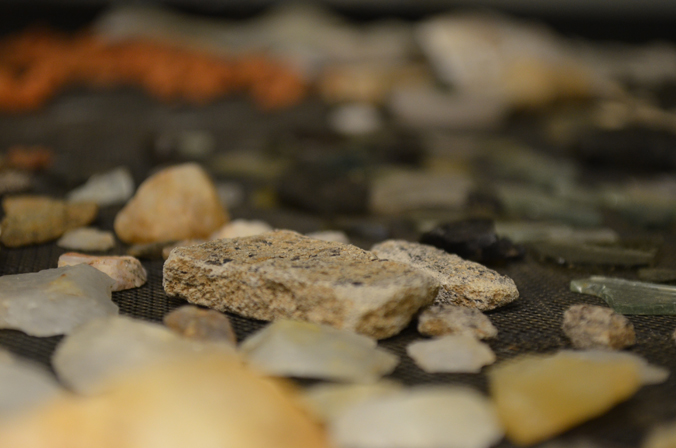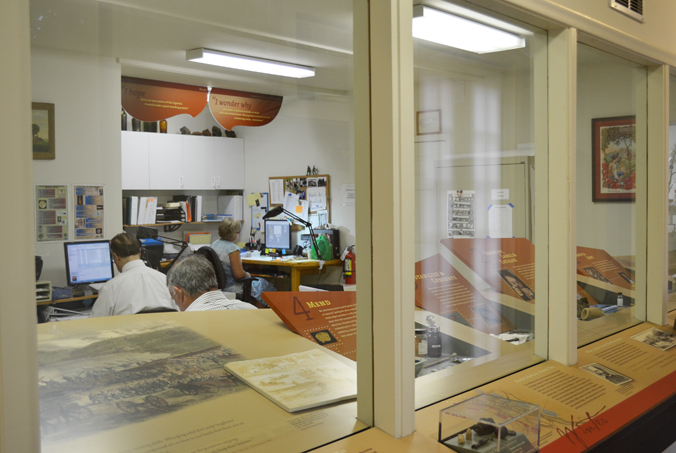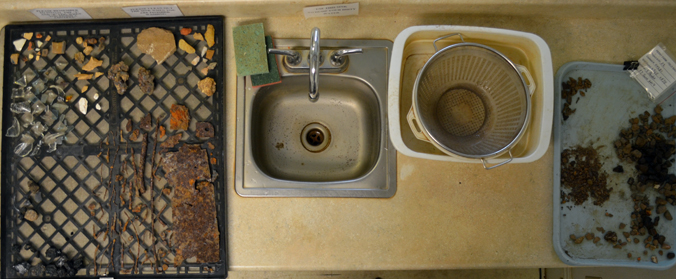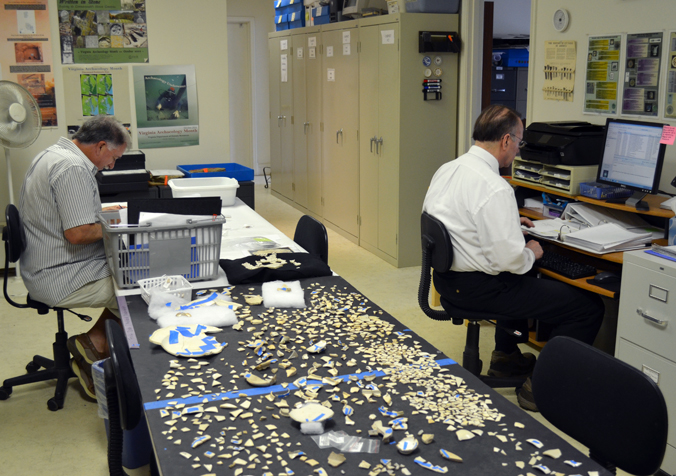Here at Ferry Farm for the last 13 years, professional archaeologists have been exploring the local landscape, digging hundreds of excavation units in their quest to reveal the history of all those who lived here, including, of course, the Washington family. Their investigative efforts have resulted in a multitude of artifacts dating from the earliest prehistoric Native American occupation of this riverine site, through the Colonial and Civil War periods, all the way to a 1990s occupation of the farm.
So, what happens to all the artifacts that are uncovered and dug up with trowels and shovels? All of those items are important pieces to the puzzle of reconstructing the history of this site, but only if they are cleaned up and recognizable. That is the purpose of the archaeology lab here at George Washington’s Ferry Farm. With the help of both professional staff and dedicated volunteers, every single artifact that has come out of the ground is washed, dried, identified, labelled, and, finally, catalogued into a searchable computer database.
The archaeology lab is located within the Ferry Farm Visitor Center which houses museum exhibits, storage rooms for the artifacts, and other administrative offices. Visitors making their way through the exhibits can check out our lab spaces through large windows, allowing them a peek into our work spaces and giving them the ability to see the different processes the artifacts go through.
While archaeological excavations at Ferry Farm take place every year, actual digging occurs only three months out of the year. Artifact processing and analysis in the lab goes on for 12 months out of the year. Archaeologists often say that “1 day in the field equals 3 days in the lab” and, in general, that adage is true. Once the artifact bags come into the lab, it can be six months to one year or more before an entire artifact collection is completely processed.
So where does it all start? Well, in the wet lab…
Wet Lab
The wet lab is a small room where the artifacts are washed and dried. It is fitted out with two sinks – the artifacts are washed only with water – and a countertop to provide space for the washing process. Toothbrushes, dental picks, pipe cleaners, washtubs, and other cleaning tools are handily arranged for easy access by the staff.
The washing process is pretty straightforward. The artifacts, covered with dirt from the field excavation, are poured out of the bag onto a tray. The washer separates the different items on the tray and proceeds to carefully wash them with a tooth brush and water. After a quick rinse, the washed items are placed on a tray covered with mesh and the tray is placed in a drying rack. The washing process can be seen in this video. The artifacts stay on the drying racks for at least a week to make sure they are completely dried before being bagged. Large windows allow visitors to watch this process and to see the “treasures from the earth” as they are uncovered and completely revealed, often for the first time in 200 years or more!
Dry Lab
The dry lab is a larger space containing desk space for the staff, the small finds cabinets, and long tables used for labeling and other projects. It is here that the dried artifacts are placed into acid-free plastic bags, catalogued, and then labelled by the staff and volunteers. Our staff spends quite a bit of time cataloguing the artifacts, which involves identifying, counting, measuring, and weighing all the artifacts. The cataloging process can be seen in this video. Each artifact is labeled with identifying information and the address of the exact location where it was found on the site. Research is always an ongoing activity as identifying and dating specific artifacts helps in understanding Ferry Farm’s past and the people who once occupied this ground.
Time is also spent on the mending, conservation, and analysis of artifact collections. The small finds cabinets contain hundreds of unique artifacts that are studied because of their personal relationships to the individuals that lived here. Long term projects, such as our current white-salt glazed ceramic mending, take place in the dry lab space, where a table covered with hundreds of ceramic sherds awaits matching. And as with the wet lab, museum visitors can look through the windows and observe all the projects being currently worked on.
Having an archaeology lab on site is very convenient for the archaeologists that work at Ferry Farm as it allows them easy access to the artifacts at all stages of their processing. Future plans for Ferry Farm rely on knowing what has been found here and weaving together that data with the historical record. It also gives the public an exciting chance to see all the work that goes into getting the artifacts ready for further research.
Judy Jobrack, Archaeologist
Assistant Lab Supervisor



